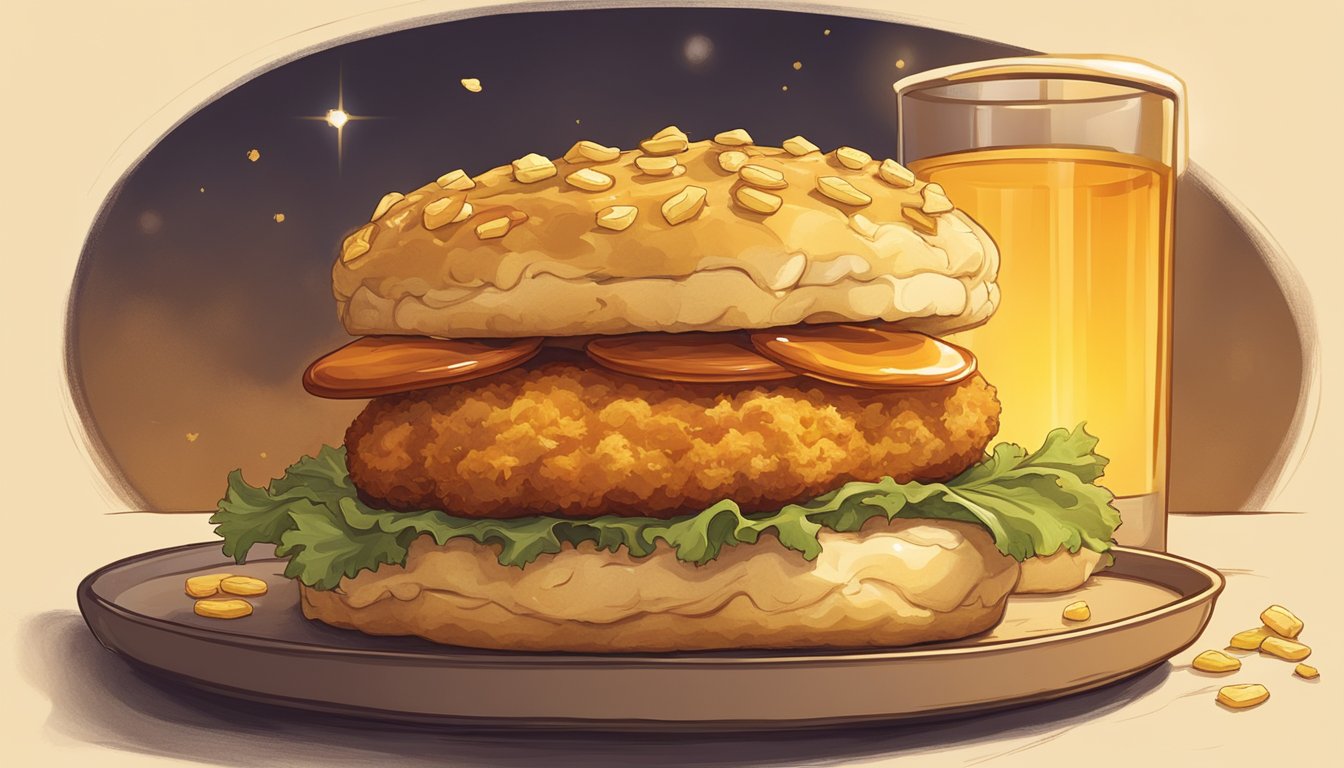The Honey Butter Chicken Biscuit has become a beloved breakfast staple for many fast food enthusiasts. This cult favorite combines the perfect balance of sweet and savory flavors, creating a unique and satisfying morning meal. The dish typically consists of a crispy breaded chicken strip nestled between a fluffy, buttery biscuit, generously slathered with sweet honey butter sauce.
Fast food chains like Whataburger and Church’s Texas Chicken have popularized this indulgent breakfast item, each offering their own take on the classic combination. The Honey Butter Chicken Biscuit’s appeal lies in its ability to satisfy both sweet and savory cravings simultaneously, making it a go-to choice for those seeking a hearty breakfast or a late-night treat.
While not the healthiest option on the menu, the Honey Butter Chicken Biscuit has garnered a dedicated following. Its popularity has even inspired some restaurants to create spin-off dishes, such as Church’s Honey-Butter Biscuit Tenders, further cementing its status as a beloved fast food item.
The Origin and Popularity of Honey Butter Chicken Biscuits
The Honey Butter Chicken Biscuit has become a beloved breakfast staple, combining Southern comfort food traditions with fast-food convenience. Its rise to fame is closely tied to regional tastes and innovative restaurant chains.
History of the Dish
The Honey Butter Chicken Biscuit emerged from the rich culinary traditions of the American South. Biscuits have long been a breakfast favorite in this region, often served with various toppings and fillings. The addition of fried chicken to biscuits became popular in the mid-20th century.
The honey butter element likely developed as a way to enhance the savory flavors of the chicken and biscuit. This sweet and salty combination appealed to many palates, leading to its increased popularity.
Fast-food chains began incorporating this dish into their menus in the late 20th and early 21st centuries, standardizing the recipe and making it widely available.
What Makes It a Cult Favorite
The Honey Butter Chicken Biscuit’s cult status stems from its perfect blend of flavors and textures. The flaky, buttery biscuit provides a satisfying base for the crispy fried chicken. The honey butter adds a touch of sweetness that complements the savory elements.
This combination hits multiple pleasure centers in the brain, creating a craving that keeps customers coming back. The dish also strikes a balance between indulgence and comfort, making it an ideal choice for breakfast or late-night snacking.
Its popularity has been fueled by social media, with fans sharing photos and reviews online. This word-of-mouth marketing has helped solidify its status as a must-try item for food enthusiasts.
Influence of Whataburger on Its Fame
Whataburger, a Texas-based fast-food chain, played a significant role in popularizing the Honey Butter Chicken Biscuit. Their version of the dish became a signature menu item, sparking a cult following among customers.
Whataburger’s success with the Honey Butter Chicken Biscuit led to increased demand and availability. The chain’s marketing efforts and consistent quality helped establish the dish as a cultural icon in Texas and beyond.
Other fast-food chains have since introduced their own versions, but Whataburger’s remains particularly beloved. The company’s limited breakfast hours have even added to the allure, creating a sense of exclusivity around the dish.
Ingredients Breakdown
The Honey Butter Chicken Biscuit owes its popularity to the careful selection and combination of key ingredients. Each component plays a crucial role in creating the perfect balance of flavors and textures.
The Role of Honey
Honey is the star sweetener in this dish, providing a natural and complex sweetness. Wildflower honey is often preferred for its floral notes and robust flavor profile. It enhances the overall taste and creates a sticky glaze when combined with butter.
Avocado honey, with its rich, buttery flavor, can be an excellent alternative. Its darker color and more intense taste add depth to the honey butter mixture.
The type of honey used can significantly impact the final flavor. Local honey varieties may be used to give the dish a unique regional twist.
Types of Butter Used
Butter is essential for creating the rich, creamy texture of the honey butter spread. Unsalted butter is typically used to allow for better control of the overall salt content in the dish.
European-style butter, with its higher butterfat content, can elevate the luxurious mouthfeel of the spread. Some recipes call for cultured butter to add a tangy note.
Clarified butter or ghee may be used in some variations, offering a nuttier flavor and longer shelf life.
Choosing the Right Chicken Cut
The choice of chicken cut greatly influences the texture and flavor of the final product. Chicken breast is the most common choice, prized for its lean meat and ability to crisp up nicely when fried.
Chicken thighs are sometimes used for their richer flavor and juicier texture. They tend to remain moist even when cooked at high temperatures.
Boneless cuts are preferred for ease of eating, but bone-in pieces can offer more flavor. The chicken is often brined or marinated to enhance its tenderness and taste.
Importance of Quality Flour
All-purpose flour is the foundation of the biscuit component. Its protein content strikes a balance between tenderness and structure, resulting in a flaky yet sturdy biscuit.
Some recipes incorporate cake flour for a lighter texture or bread flour for a chewier bite. The quality of flour affects the biscuit’s rise, texture, and overall mouthfeel.
Whole wheat flour may be added in small quantities to introduce a nutty flavor and boost nutritional value. Proper measuring and handling of flour are crucial to achieve the ideal biscuit consistency.
Biscuit Making Essentials
Creating the perfect biscuit requires attention to detail and understanding key ingredients. The right techniques and components can elevate a simple biscuit to a flaky, buttery masterpiece.
Crafting the Buttery Biscuit
To achieve a deliciously buttery biscuit, use cold butter cut into small cubes. Work it into the dry ingredients until the mixture resembles coarse crumbs. This creates pockets of butter that melt during baking, resulting in flaky layers.
For extra richness, brush the tops with melted butter before and after baking. Some recipes call for buttermilk, which adds tanginess and helps activate the leavening agents.
A light touch is crucial when mixing the dough. Overworking can lead to tough biscuits. Mix until just combined, then gently pat or roll out the dough.
Selecting Your Leavening Agent
Baking powder is the most common leavening agent for biscuits. It creates carbon dioxide bubbles that help the dough rise and become fluffy. Double-acting baking powder provides two rises – one when mixed with liquid and another when heated.
Some recipes use a combination of baking powder and baking soda. Baking soda requires an acidic ingredient like buttermilk to activate. This combo can produce a more complex flavor and tender texture.
For best results, check that leavening agents are fresh. Old or expired products may not provide adequate rise.
The Texture of a Perfect Biscuit
The ideal biscuit texture is a balance of flaky and tender. To achieve this, handle the dough minimally and use cold ingredients. Folding the dough creates layers, resulting in a flaky exterior.
For a tender interior, avoid overmixing. Mix dry and wet ingredients just until combined. Some recipes suggest leaving small bits of flour visible in the dough.
The baking temperature affects texture too. A hot oven (around 425°F) helps create a crisp exterior while keeping the inside soft. Biscuits are typically done when golden brown on top.
Proper cooling is essential. Let biscuits rest for a few minutes after baking to set their structure before serving.
Marrying the Flavors
The Honey Butter Chicken Biscuit’s irresistible appeal lies in its perfect balance of sweet and savory elements. This harmonious blend starts with a carefully crafted honey butter sauce, precisely seasoned chicken, and a delicate equilibrium of flavors.
Creating the Perfect Honey Butter Sauce
The honey butter sauce is the star of this culinary creation. It combines sweet honey with rich, creamy butter to form a velvety smooth consistency. The ratio of honey to butter is crucial – too much honey can overpower the savory elements, while too little may not provide enough sweetness.
Some recipes incorporate a touch of vanilla extract or cinnamon to add depth to the sauce’s flavor profile. The sauce is typically warmed slightly before application, allowing it to spread evenly and meld seamlessly with the other components.
Seasoning the Chicken Accurately
The chicken’s seasoning plays a vital role in complementing the sweet honey butter. A blend of salt, black pepper, and garlic powder forms the base of most seasoning mixes. Some variations include paprika or a hint of cayenne for a subtle kick.
Cajun seasoning is another popular choice, offering a complex flavor profile that pairs well with the sweet honey butter. The key is to apply the seasoning generously but evenly, ensuring each bite of chicken delivers a consistent taste experience.
Balancing the Sweet and Savory
Achieving the perfect balance between sweet and savory flavors is essential. The sweetness of the honey butter must not overshadow the savory notes of the seasoned chicken. Conversely, the chicken’s seasoning should complement, not compete with, the honey butter’s sweetness.
The biscuit itself serves as a neutral canvas, absorbing flavors from both the chicken and the honey butter. Its buttery, slightly salty taste helps bridge the gap between sweet and savory elements.
Texture also plays a role in this balance. The crispy exterior of the chicken contrasts with the soft, fluffy biscuit and the smooth honey butter, creating a satisfying mouthfeel that enhances the overall flavor experience.
Cooking Techniques
Achieving the perfect honey butter chicken biscuit requires mastering key cooking techniques. Proper frying methods and temperature control are essential for creating crispy, juicy chicken.
Frying the Chicken to Perfection
To fry chicken for a honey butter chicken biscuit, start by brining the meat in pickle juice for 2-6 hours. This enhances flavor and moisture retention. After brining, dredge the chicken in a mixture of flour and potato starch.
Heat oil to 350°F (175°C) in a deep fryer or heavy-bottomed pot. Carefully lower the chicken into the hot oil. Fry for 8-10 minutes, until golden brown and cooked through.
Use a thermometer to ensure the chicken reaches an internal temperature of 165°F (74°C). Let the fried chicken rest on a wire rack to maintain crispiness.
Baking vs. Deep-Frying
While deep-frying produces the crispiest exterior, baking offers a healthier alternative. To bake chicken for this dish, preheat the oven to 425°F (218°C). Place breaded chicken on a wire rack set over a baking sheet.
Bake for 20-25 minutes, flipping halfway through. The chicken may not achieve the same level of crispiness as deep-fried versions, but it will still have a satisfying texture.
Spray the chicken with oil before baking to enhance browning. For extra crunch, finish under the broiler for 1-2 minutes. Allow baked chicken to rest before assembling the biscuit.
Variations of the Classic
The beloved honey butter chicken biscuit has inspired numerous creative adaptations. These variations cater to diverse tastes and dietary needs while maintaining the essence of the original.
Spicy Honey Butter Chicken Biscuit
This fiery twist adds a kick to the classic recipe. Restaurants often incorporate hot sauce or cayenne pepper into the honey butter mixture. Some versions use spicy breading on the chicken. Others add jalapeños or pepper jack cheese.
The heat level varies, allowing customers to choose their preferred spiciness. Fast food chains may offer limited-time spicy versions to attract adventurous eaters.
Health-Conscious Alternatives
For those watching their calories, lighter versions of the honey butter chicken biscuit exist. These substitutions aim to reduce fat and increase nutritional value:
- Grilled chicken instead of fried
- Whole wheat or low-carb biscuits
- Greek yogurt-based honey butter spread
- Turkey bacon as an added protein
Some recipes swap the biscuit for a lettuce wrap or use plant-based chicken alternatives. These options cater to various dietary restrictions while preserving the core flavors.
Homemade Versions and Copycat Recipes
Many food enthusiasts recreate their favorite restaurant honey butter chicken biscuits at home. Popular copycat recipes mimic Whataburger and Church’s Chicken versions.
Key components of homemade recipes:
- Buttermilk-brined chicken
- Flaky, buttery biscuits from scratch
- Homemade honey butter (often with a touch of cinnamon)
Cooking methods vary, with some opting for air fryers to reduce oil. Others experiment with different honeys or add unique spices to create signature flavors.
Nutritional Profile

The Honey Butter Chicken Biscuit packs a substantial caloric punch. A single serving typically contains around 500 calories, making it a hefty breakfast option.
In terms of macronutrients, this dish is predominantly composed of fats and carbohydrates. The fat content accounts for approximately 53% of the total calories, while carbohydrates contribute about 36%.
Protein makes up the remaining 11% of the caloric content. A single biscuit provides about 25% of the daily recommended protein intake for an average adult.
Here’s a breakdown of the key nutritional components:
| Nutrient | Amount | % Daily Value |
|---|---|---|
| Calories | 500 | – |
| Fat | 29g | 37% |
| Carbs | 45g | – |
| Protein | 14g | 25% |
It’s worth noting that this dish is high in saturated fats and sodium. These factors should be considered for those monitoring their intake of these nutrients.
The biscuit’s ingredients include enriched flour, buttermilk, palm oil, and various additives. The chicken and honey butter components contribute additional fats and sugars to the overall nutritional profile.
Serving and Accompaniments
The Honey Butter Chicken Biscuit pairs well with various side dishes and can be enjoyed as part of a larger meal. Traditional Southern sides complement its flavors, while innovative pairings offer exciting taste combinations.
Traditional Side Dishes
Coleslaw is a classic accompaniment to chicken biscuit sandwiches. Its cool, crunchy texture balances the warm, soft biscuit. Many restaurants serve a small portion of slaw on the side.
Grits, a Southern staple, make an excellent pairing. Creamy and comforting, they contrast nicely with the crispy chicken. Some establishments offer cheese grits for added richness.
Cornbread is another popular side. Its slightly sweet flavor complements the honey butter. It’s often served warm, sometimes with extra butter on the side.
Hash browns or country potatoes frequently appear alongside this breakfast item. Their crispy exterior and soft interior provide a satisfying texture contrast.
Innovative Pairing Ideas
Fruit salad offers a refreshing counterpoint to the rich sandwich. A mix of seasonal fruits can cut through the richness and provide a lighter option.
Roasted vegetables like sweet potatoes or Brussels sprouts add a nutritious element. Their caramelized flavors work well with the honey butter.
Spicy pickles or pickled vegetables bring acidity and heat. They can help balance the sweetness of the honey butter and add complexity to the meal.
Some creative chefs pair the biscuit with unexpected items like kimchi or mango salsa. These bold flavors create unique taste experiences for adventurous diners.
Making the Biscuit at Home
Creating homemade biscuits is a rewarding process that yields delicious results. With the right ingredients and techniques, you can achieve flaky, buttery biscuits that rival any restaurant version.
Step-by-Step Recipe Guide
Mix 2 cups all-purpose flour, 1 tablespoon baking powder, 1 teaspoon salt, and 1 tablespoon sugar in a large bowl.
Cut 6 tablespoons cold butter into small cubes and work it into the flour mixture using a pastry cutter or your fingers until it resembles coarse crumbs.
Slowly add 3/4 cup cold buttermilk, stirring until the dough comes together.
Turn the dough onto a floured surface and gently knead 3-4 times.
Pat the dough into a 1-inch thick rectangle and cut into circles using a biscuit cutter.
Place biscuits on a baking sheet and brush tops with melted butter.
Bake at 425°F for 12-15 minutes until golden brown.
Tips for a Successful Homemade Biscuit
Use cold ingredients to ensure flaky layers. Handle the dough as little as possible to prevent tough biscuits. For extra flavor, add herbs or cheese to the dough.
When cutting biscuits, press straight down without twisting the cutter. This helps the biscuits rise evenly.
For a crispy exterior, place biscuits close together on the baking sheet. For softer sides, space them apart.
Brush biscuits with honey butter immediately after baking for added sweetness and shine. Let them cool slightly before serving to allow the texture to set.




